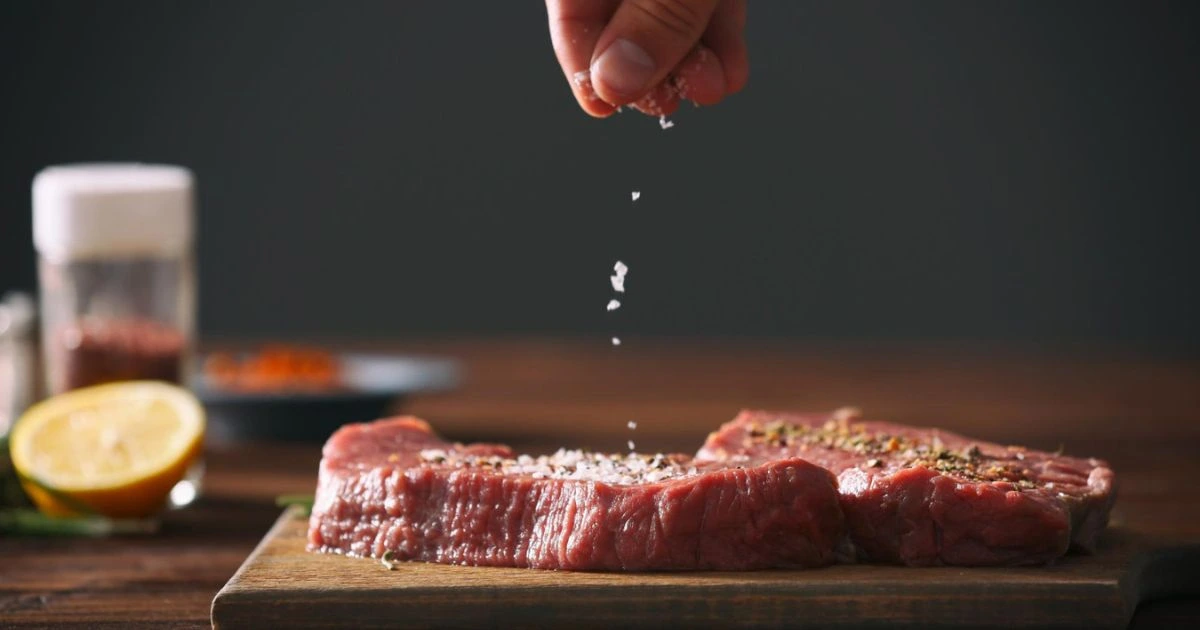The sizzle of a perfectly seasoned steak can turn a simple meal into a memorable experience. Every home cook knows that mastering steak seasoning is key to making meals that rival restaurants. It’s all about creating that special touch in your kitchen.
Making the best steak seasoning is more than just mixing spices. It’s an art that combines herbs and spices to bring out the best in each cut of beef. Whether you’re grilling a tender ribeye or exploring flavorful flank steak recipes, the right seasoning can make your dish unforgettable.
Imagine the aroma of freshly ground black pepper, garlic powder, and sea salt blending together. This creates a flavor that makes your taste buds sing. This guide will show you how to make a signature steak seasoning that will wow your family and friends.
We’ll dive into the world of flavor combinations and the right ingredients. You’ll learn how a well-crafted seasoning blend can take your steaks from good to great. Get ready to discover the secrets of making the most delicious steak seasoning you’ve ever tasted.
The Secret Behind Perfect Steak Seasoning
Making great homemade steak seasoning is like turning a simple cut of beef into a work of art. The right seasoning can take your cooking from good to amazing. It brings out the meat’s natural taste and adds depth.
Table of Contents
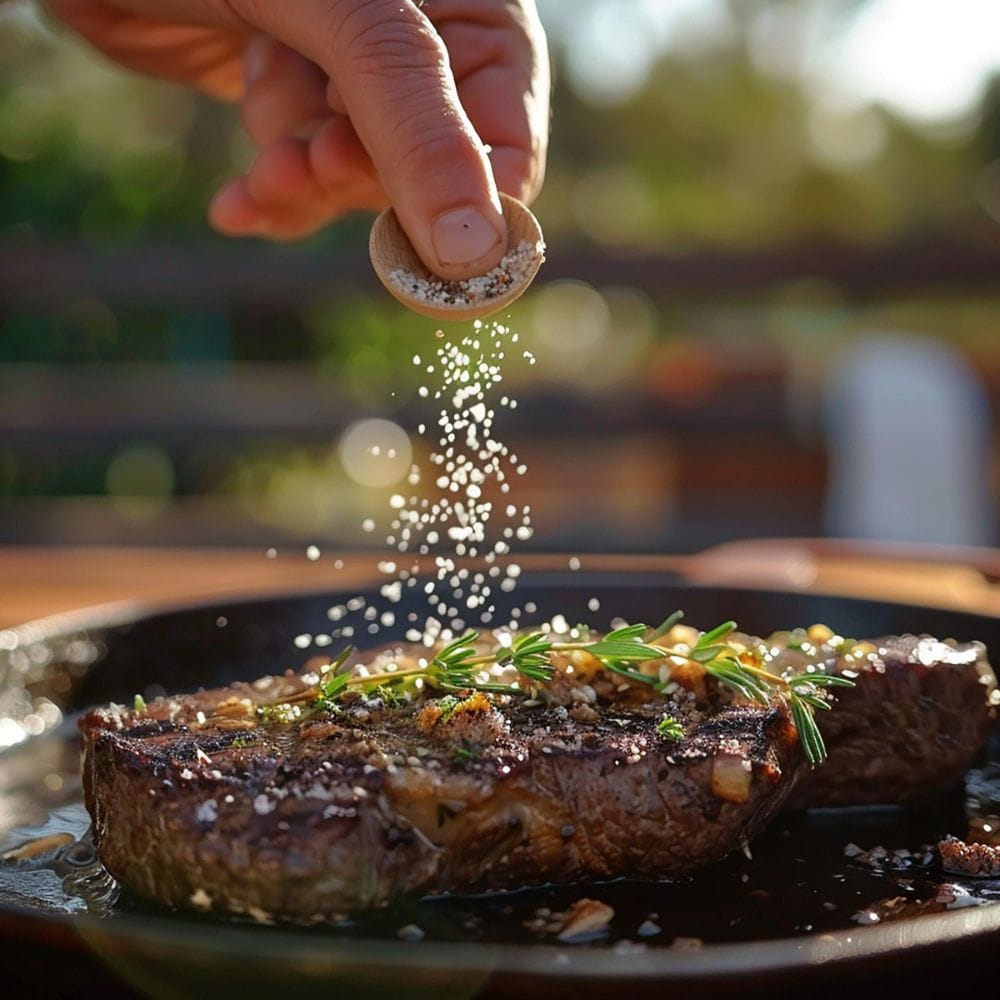
Flavorful Steak Seasoning for Juicy Steaks
Ingredients
Equipment
Method
- Add all dry ingredients to a small mixing bowl.
- Whisk or stir until evenly combined.
- Store in an airtight container in a cool, dark place for up to 3–6 months.
- To use: Pat steaks dry, lightly coat with oil, then sprinkle about 1 tablespoon of seasoning per pound of steak.
- Rub gently into the meat and let rest at room temperature for 20–60 minutes before cooking.
Notes
- Use dried herbs for long-term storage; fresh herbs should only be added right before cooking.
- Store seasoning away from light, moisture, and heat to keep flavors potent.
- Adjust salt level depending on steak cut and dietary preference.
- Experiment with regional variations: Southwest (chili + cumin), Mediterranean (oregano + rosemary), Asian-inspired (ginger + garlic).
- Make small batches often to ensure maximum freshness and flavor.
Understanding Flavor Profiles
A top-notch steak seasoning combines different tastes for a perfect flavor mix. Chefs know seasoning is more than salt and pepper. It’s about creating a flavor symphony that matches the beef’s natural taste.
Why Seasoning Makes a Difference
- Enhances natural meat flavors
- Creates a delicious exterior crust
- Adds complexity to the overall taste
- Improves meat texture and tenderness
Balance of Herbs and Spices
Creating the perfect steak rub is all about the right mix of ingredients. Here’s what you need:
| Flavor Component | Purpose | Examples |
| Salt | Enhances natural flavors | Kosher salt, sea salt |
| Sweet | Balances savory notes | Brown sugar, paprika |
| Spicy | Adds depth and heat | Black pepper, chili powder |
| Herbal | Provides aromatic complexity | Dried thyme, rosemary |
Getting good at homemade steak seasoning takes time. Begin with small batches and try different mixes. Don’t hesitate to create your own unique seasoning that shows off your taste.
Essential Ingredients for Steak Seasoning
Making the perfect steak seasoning blend is all about picking the right ingredients. These ingredients should enhance the beef’s natural taste. A great mix can turn any steak into a dish to remember.
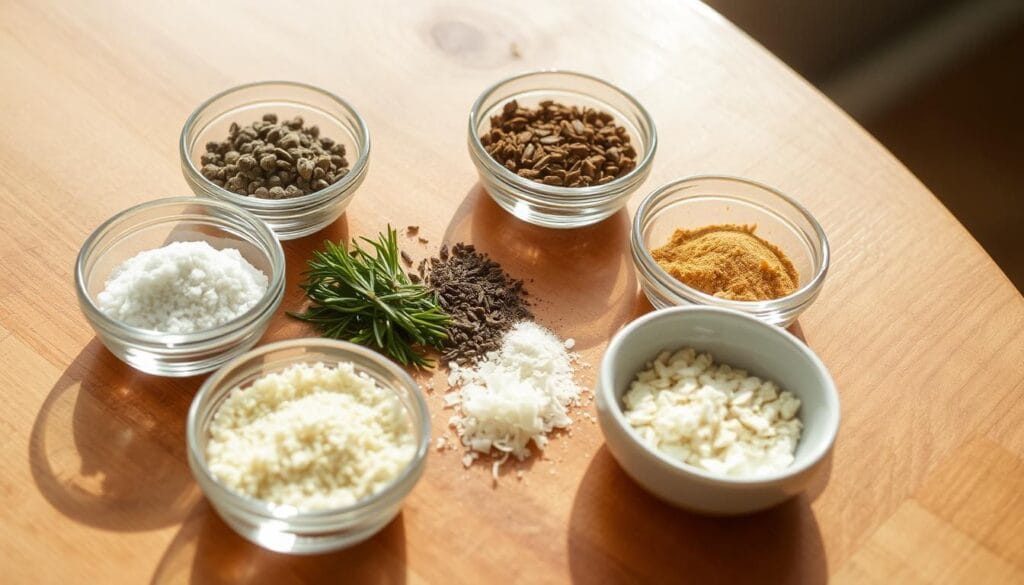
Core Spices and Their Flavor Profiles
Understanding each spice is key to a top-notch steak seasoning. Each spice adds its own flavor to the mix:
- Black Pepper: Gives a sharp, warm taste
- Smoked Paprika: Brings depth and a hint of smokiness
- Garlic Powder: Offers a strong, concentrated flavor
- Ground Cumin: Adds earthy, warm notes
Salt: The Critical Flavor Enhancer
Salt is vital in any steak seasoning. Different salts have different tastes and mineral content:
| Salt Type | Flavor Profile | Best Used For |
| Kosher Salt | Clean, pure taste | General seasoning |
| Sea Salt | Mineral-rich complexity | Finishing steaks |
| Himalayan Pink Salt | Subtle mineral notes | Gourmet seasoning blends |
Fresh vs. Dried Herbs in Seasoning
Choosing between fresh and dried herbs changes the seasoning’s flavor. Dried herbs pack more flavor and last longer. Fresh herbs give a bright, immediate taste.
- Dried herbs are best for long-term storage
- Fresh herbs offer immediate, vibrant flavors
- Using both can create a complex seasoning
How to Create Your Signature Steak Seasoning
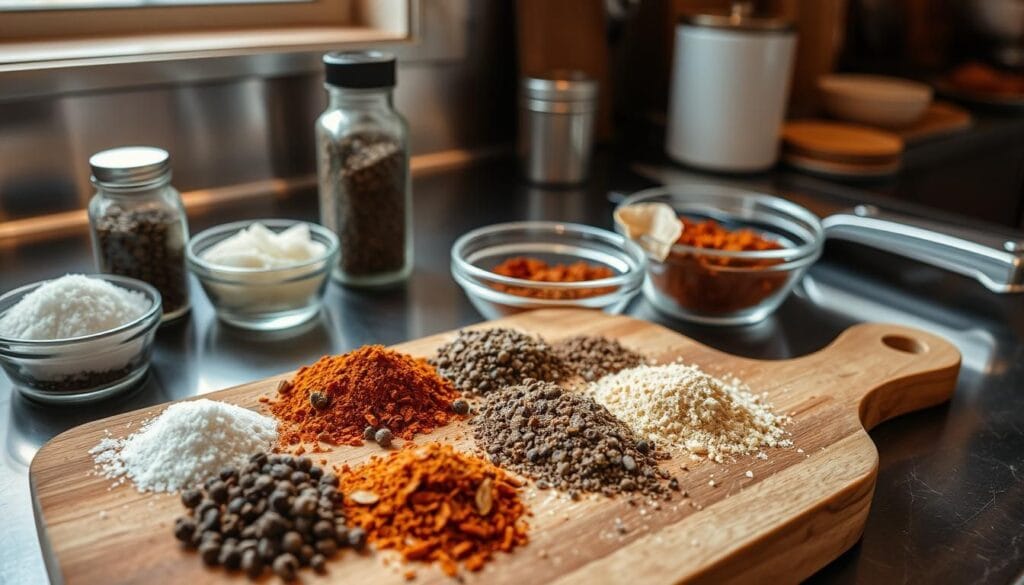
Making the perfect seasoning for steak is like creating a work of art. It turns a simple cut into a dish that wows everyone. A custom steak dry rub lets you add your own special flavors, making every bite exciting.
Begin by picking the main ingredients for your steak seasoning mix. It’s all about finding the right balance of flavors that enhance the meat’s natural taste.
- Kosher salt as the primary base
- Freshly ground black pepper
- Granulated garlic powder
- Dried herbs like thyme or rosemary
- Smoked paprika for depth
To mix your steak dry rub, follow these steps:
- Put all dry ingredients in a small bowl
- Whisk well to mix everything evenly
- Keep it in an airtight container
- Spread it on steaks 20-30 minutes before cooking
Pro tip: Try different amounts to find your perfect seasoning mix. Some like it strong, while others prefer it milder.
The best thing about making your own steak seasoning is how flexible it is. You can change the spice level, add spices from different places, or make a mix that’s just right for you. A great steak dry rub can turn any meat into a dish that’s as good as a restaurant’s.
Best Practices for Applying Steak Seasoning
Learning how to season steak can turn a simple cut of meat into a gourmet dish. The right seasoning mix needs careful application and technique to bring out the best flavors.
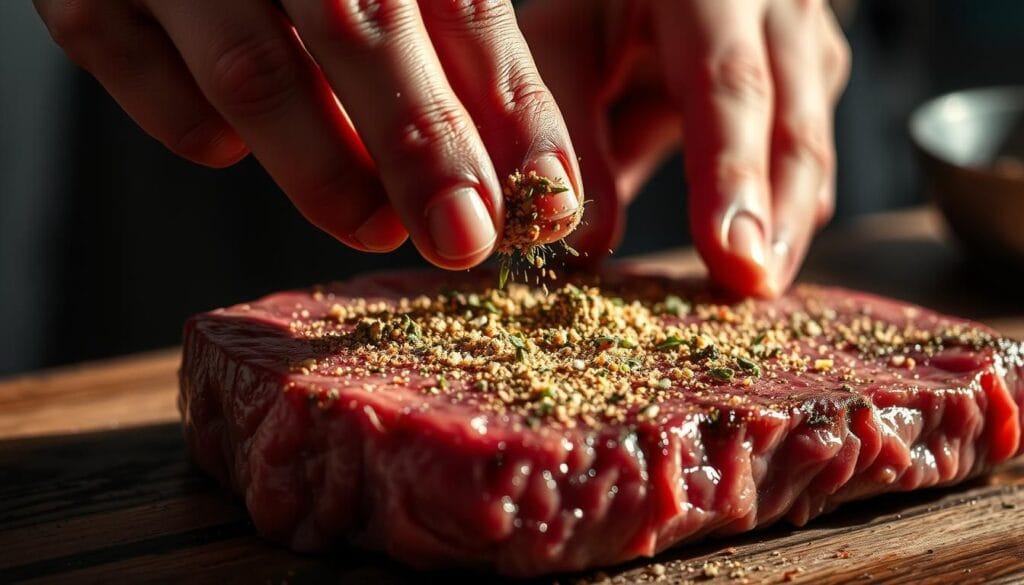
Timing and Temperature Considerations
When it comes to seasoning, timing is everything. For the best results, keep these tips in mind:
- Season steaks 40-60 minutes before cooking
- Let the meat come to room temperature
- Pat the steaks dry before seasoning
Application Techniques
Experts suggest certain ways to apply steak seasoning:
- Evenly sprinkle seasoning on both sides
- Gently rub it into the meat’s surface
- Use about 1 tablespoon per pound of steak
“The secret is even distribution and gentle massaging of the seasoning,” says Chef Michael Rodriguez.
Amount of Seasoning Per Pound
Getting the seasoning right is key. Too little, and the meat tastes bland. Too much, and it overpowers the beef’s natural taste. Use roughly one tablespoon of homemade steak seasoning recipe per pound of meat.
Pro tip: Some chefs suggest lightly coating the steak with high-heat oil before seasoning. This helps the spices stick better and creates a tasty crust.
Traditional vs Modern Steak Seasoning Methods
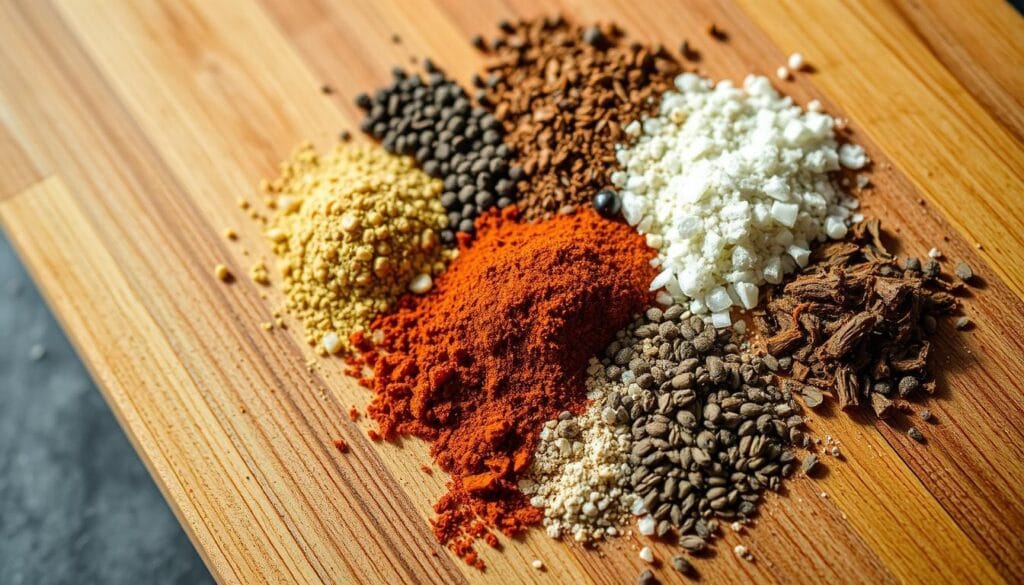
Steak seasoning has changed a lot over time. What started with just salt and pepper has grown into a complex art. To find the best seasoning for steak, we need to look at both old and new ways.
Old-school steak seasoning was all about keeping it simple. People used:
- Kosher salt
- Freshly ground black pepper
- Basic herb blends
Nowadays, seasoning steak is all about trying new things. Chefs are using complex flavors to make steaks taste amazing. They’re mixing:
- Global spice combinations
- Exotic herb mixtures
- Specialized dry rubs
The main difference is in how complex and diverse the flavors are. The old ways were simple, but now, chefs love to get creative. This means steak lovers have more ways than ever to enjoy their meals.
“Great steak seasoning is about understanding flavor, not just following rules.” – Chef Michael Rodriguez
The way we season steak shows how cooking has changed. From traditional steakhouse flavors to new, bold mixes, everyone is exploring. Home cooks and chefs alike are always looking to make the perfect seasoning for their steaks.
Customizing Your Steak Seasoning Blend
Making your own steak seasoning rub is like creating a work of art. It turns a simple meal into a feast for the senses. Every chef knows that the right seasoning can make any steak taste amazing.
What makes homemade seasoning so great is how flexible it is. You can tweak it to fit your taste and cooking style perfectly.
Regional Flavor Inspirations
Steak seasoning varies by region. Here are some flavors to try:
- Southwest Style: Add cumin and chili powder
- Mediterranean Twist: Incorporate dried oregano and rosemary
- Asian-Inspired: Mix in ground ginger and garlic powder
Heat Level Customization
For those who love spice, you can adjust the heat:
- Mild: Use minimal black pepper
- Medium: Add crushed red pepper flakes
- Hot: Incorporate cayenne pepper or chipotle powder
Specialty Ingredient Additions
| Ingredient | Flavor Profile | Recommended Amount |
| Brown Sugar | Sweet and Caramelizing | 1-2 teaspoons per 1/4 cup blend |
| Smoked Paprika | Rich and Smoky | 1-2 teaspoons per 1/4 cup blend |
| Ground Coriander | Citrusy and Warm | 1 teaspoon per 1/4 cup blend |
Try mixing different ingredients to find your favorite seasoning. The goal is to find the perfect balance that you love.
Storage and Shelf Life Tips
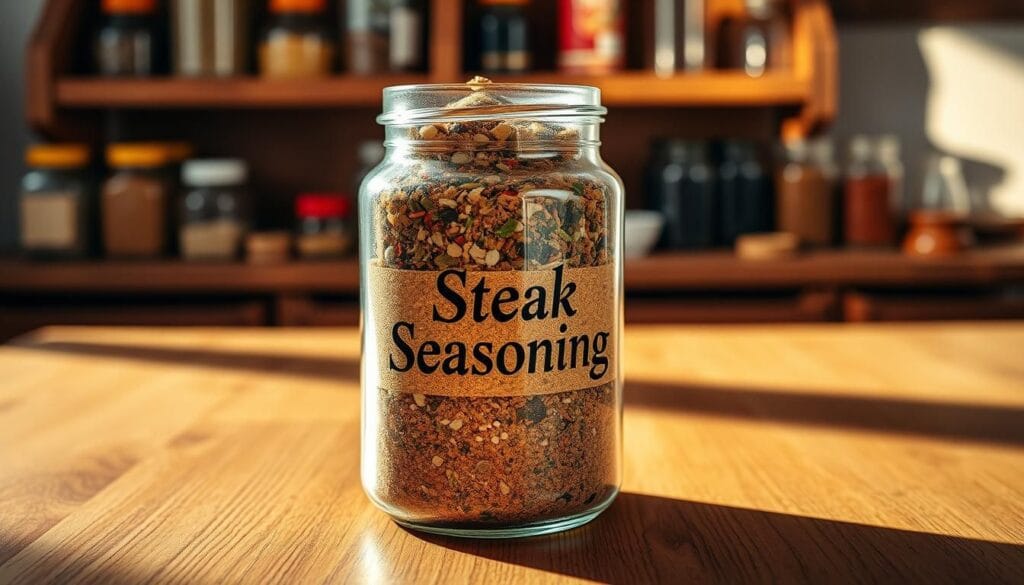
Keeping your homemade steak seasoning blend fresh is key. The right storage keeps its flavor strong for months. This way, your spice mix stays delicious and potent.
Choosing the right container is important. Pick one that keeps moisture, light, and air out. Glass jars or ceramic containers are great for keeping spices fresh.
- Store in a cool, dark pantry away from direct sunlight
- Use containers with airtight seals
- Keep away from heat sources like stoves or ovens
- Avoid storing near humid areas like dishwashers
Your steak seasoning blend stays flavorful for 3-6 months if stored right. Look out for these signs it’s gone bad:
- Loss of vibrant color
- Diminished aroma
- Clumping or moisture buildup
- Unusual smell or taste
To keep your seasoning fresh, make smaller batches often. This way, you always have a fresh blend to enhance your steak’s taste.
Common Steak Seasoning Mistakes to Avoid
Making great steak seasoning takes skill and care. Many home cooks make mistakes that ruin a good steak. Knowing these common errors can help you make your steak seasoning better.
To master steak seasoning, avoid a few key mistakes. These can ruin the flavor and quality of your steak:
Overseasoning Challenges
One big mistake is using too much seasoning. Too many spices can hide the beef’s natural flavor. The goal is to add to the meat’s taste, not cover it up.
- Use a light hand when applying seasoning
- Aim for a thin, even coating
- Remember that quality beef requires minimal intervention
Timing Troubles
When you season your steak matters a lot. It affects the taste and texture. Seasoning isn’t just about what you use, but when you apply it.
- Avoid seasoning too far in advance, which can draw out moisture
- Ideally, season just before cooking
- Allow seasoning to sit for 15-30 minutes at room temperature
Storage Concerns
Storing seasoning wrong can make it useless. Moisture, heat, and light can spoil your spice mix fast.
- Store seasoning in airtight containers
- Keep away from direct sunlight and heat
- Replace spice blends every 3-6 months
By avoiding these mistakes, you’ll make steaks that taste like they’re from a restaurant. They’ll impress anyone.
Conclusion
Creating the best seasoning for steak is more than just a skill, it’s an art. It turns ordinary beef into an extraordinary meal. Steak seasoning is not just about adding flavor. It’s about knowing how spices and herbs work together to enhance the meat‘s natural taste.
Home cooks can achieve professional results by trying their own seasoning blends. The secret is to mix strong spices, choose good salt, and know how ingredients match the beef’s taste. Professional chefs say a great seasoning can make any cut taste like it’s from a restaurant.
Your steak seasoning journey is just starting. Every blend you make will teach you about flavors, how to use them, and what you like. Whether it’s a ribeye for a special event or a simple dinner, your seasoning will make your meals unforgettable.
Remember, practice is key. Every top chef began where you are now, curious, eager, and ready to make magic with food. Your journey to becoming a seasoning expert starts with learning, trying new recipes, and enjoying the process.
FAQ
What makes a great steak seasoning blend?
A great steak seasoning blend has the right mix of salt, herbs, and spices. It should bring out the beef’s natural flavors without overpowering it. The goal is to create a blend that complements the steak’s taste while adding depth.
How long should I season a steak before cooking?
Seasoning time varies based on the steak’s cut and thickness. For thin steaks, season right before cooking. Thicker steaks can be seasoned 40 minutes to an hour ahead. This lets the salt enhance the meat’s flavor. But don’t season too early, as it can dry out the meat.
Can I use the same seasoning for different cuts of steak?
While a versatile seasoning works for most steaks, adjust it for different cuts. Leaner steaks like flank steak might need more seasoning. Meanwhile, premium cuts like ribeye should have a lighter touch to keep their flavor intact.
How long can I store homemade steak seasoning?
Homemade steak seasoning stays fresh for 3-6 months in an airtight container. Keep it in a cool, dry place. Check it regularly for any signs of spoilage, like clumping or off smells.
What are the must-have spices for a basic steak seasoning?
A classic steak seasoning includes kosher salt, black pepper, garlic powder, and onion powder. You can add paprika, thyme, rosemary, and spices like cayenne or mustard for extra flavor.
Is there a difference between a dry rub and a seasoning?
Yes, a dry rub is more intense and often has sugar. Seasoning is lighter and focuses on enhancing the meat’s flavor. Both are spice mixes used before cooking, but rubs make a stronger crust.
Can I use fresh herbs in my steak seasoning?
Fresh herbs are best used just before or during cooking. For a seasoning blend that lasts, use dried herbs. They provide consistent flavor and prevent moisture buildup.
How much seasoning should I use per pound of steak?
Use 1-2 teaspoons of seasoning per pound of steak. Aim for a light, even coating that enhances the meat’s flavor. Adjust the amount based on your taste and the seasoning blend’s intensity.
There are no reviews yet. Be the first one to write one.

